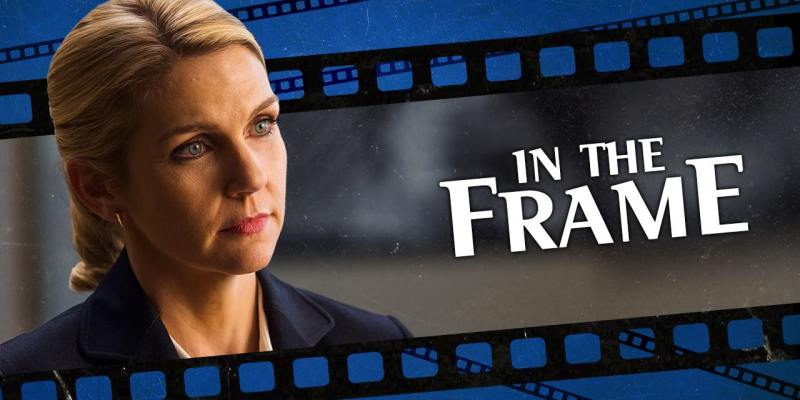There were a lot of pleasant surprises in this week’s Primetime Emmy nominations. Fantastic shows like Watchmen, Succession, and The Good Place all performed very strongly. The decision to expand many of the major categories to include between six and eight nominees largely paid off, celebrating what has been an impressive year for television. However, there was one notable omission, an omission that was even more noticeable for the fact that it occurred for the fifth year running.
Rhea Seehorn failed to pick up a nomination for Lead Actress in a Drama Series for her work as Kim Wexler on Better Call Saul. Although the six nominees in the category are all impressive in their own right and while the term “snub” is perhaps a little charged, this lack of recognition feels like an oversight. For the past five seasons, Seehorn has quietly been delivering the best performance in television. It is so good that Nick Offerman described Seehorn as “a Mount Rushmore-level actor.”
Kim Wexler is the most compelling character on television. This is impressive, considering how unlikely it initially seemed. Better Call Saul is a prequel to Breaking Bad, and many of the characters are defined by that relationship. Regulars like Jimmy McGill (Bob Odenkirk), Mike Ehrmantraut (Jonathan Banks) and Gus Fring (Giancarlo Esposito) all appeared in Breaking Bad. Even Nacho Varga (Michael Mando) and Lalo Salamanca (Tony Dalton) were first mentioned in Breaking Bad.
Kim was never mentioned in Breaking Bad, which makes her fate at the end of the prequel series the subject of much speculation. There are other characters from Better Call Saul who are unrelated to Breaking Bad, but they largely faded from importance as the show’s run went on. Jimmy’s brother Chuck (Michael McKean) committed suicide at the end of the third season, and after that Jimmy’s lawyer foil Howard Hamlin (Patrick Fabian) faded into the background of the show.

Indeed, the writing staff on Better Call Saul initially suspected that something similar might happen to Kim, with co-creator Vince Gilligan acknowledging that they thought it was a “distinct possibility” that the character would “fall out of importance” as the show progressed. She has not. If anything, Kim has pushed her way to the front of the ensemble as her relationship with Jimmy has grown more complex and as her own character has developed in interesting and challenging directions.
Kim Wexler might not have appeared on Breaking Bad, but she did have a clear antecedent. Skyler White (Anna Gunn) was the wife of Walter White (Bryan Cranston) and found herself struggling against his descent into criminality. Skyler was a polarizing character, with a vocal hatedom that actively attacked Gunn, in part because she served as a voice critiquing her husband’s journey from mild-mannered chemistry teacher to meth kingpin. Skyler was seen as “a whiner, a nag, a drag.”
History has been kind to Skyler White. Vince Gilligan argued that a lot of the backlash to Skyler was down to “misogynists, plain and simple.” Skyler was a complex and multifaceted character who reacted against Walt in her own ways — her seeming moral superiority evolving into a hypocrisy that mirrored her husband’s self-delusion. Writers like Ellen Jones and Zach Blumenfeld have since argued that Skyler was “the precursor for the modern antiheroine” and that television has only now caught up to her.
Kim Wexler occupies a similar role in Better Call Saul to the one that Skyler played in Breaking Bad. However, she is a much more dynamic and compelling character. Her complicity is much more active than Skyler’s. One of the most interesting facets of Better Call Saul is how it feels like a coda to the television antihero drama. Its refusal to mythologize Jimmy himself is a huge part of that. However, so too is its refusal to consign Kim to the stereotypical role of “the wife” in such dramas. If anything, Kim’s arc is more interesting than Jimmy’s.

A lot of this is down to Seehorn. The writing staff credits a small moment in the show’s fourth episode, “Hero,” as unlocking the character. One of Jimmy’s stunts has outraged Howard. Howard storms out of the meeting. Kim lingers. Her poker face softens. Her lips curl upward; a smile forms. She isn’t outraged by Jimmy’s juvenile behavior — she likes it. “The way she played it just felt so right that it gave us a strong feeling for where we were going with her,” explained co-creator Peter Gould.
To be fair, much of Kim’s character builds out from a short scene in the first episode. After a bad meeting, Jimmy retreats to the parking garage. He kicks over a trash can. (It is already dented; this is not the first time this has happened.) Sharing a cigarette with Kim, he implores her to help, “Couldn’t you just–?” She cuts him off, “You know I can’t.” Jimmy leaves, and Kim straightens up the trash can that Jimmy knocked over. (One gets the sense this is not the first time that this has happened.)
Over the course of the show, it becomes clear that Kim Wexler has a history with toxic and co-dependent people, having grown up with an alcoholic mother on the Kansas/Nebraska border. Kim does not shut these people out of her life, even when their behavior becomes self-destructive. Instead, she doubles down, while trying to assert control. When her mother is late collecting her from school, Kim waits. When her mother shows up clearly drunk and driving, Kim opts to walk home.
When Jimmy publicly humiliates her by embroiling her in a con without her consent, Kim’s response is not to distance herself from him, but to propose marriage — ostensibly so they will be protected by “spousal privilege.” Kim repeatedly responds to warning signs about her lover by committing harder. After they both have a bad day, Jimmy and Kim hurl beer bottles from their apartment balcony to vent frustration. The next morning, as Jimmy goes to work, Kim cleans up the broken shards below.

Much like Skyler mirrored Walt, Kim mirrors Jimmy. Jimmy is a con artist who struggles with different facets of himself — the earnest and underachieving Jimmy McGill, the cynical predator “Slippin’ Jimmy,” the savvy street-smart Saul Goodman. Gradually, Jimmy learns that these sides of himself cannot be neatly delineated, especially in terms of how other characters see him. His brother Chuck never sees Jimmy as anything more than a liar and cheat, no matter how hard Jimmy tries.
In contrast, Kim Wexler commits to compartmentalization. She places everything in her life into rigidly defined spaces. She believes that she can do good work as a pro bono criminal attorney and earn a living as a corporate lawyer for a big bank. She thinks she can stand up for the little guy and deliver millionaires everything that they want. However, she also extrapolates that outwards. She believes that the man she loves can be separated from his worst choices, even as those choices grow ever more dangerous.
Better Call Saul is built around the idea that such compartmentalization is a fantasy. Much of the first four seasons are built around a dichotomy: Jimmy and Kim’s legal-centric arc contrasts with the drug war plotline unfolding with Mike, Gus, and Lalo. The fifth season reveals that any belief these two threads could be kept separate is a delusion: They come crashing together with brutal force, to the point that Kim gets a pair of powerhouse scenes built around twin confrontations with Lalo.

This is Kim’s arc in a microcosm. As she spends more time with Jimmy, she finds those boundaries that she worked so hard to build eroding and decaying. It becomes increasingly clear that Kim doesn’t love Jimmy despite his destructive tendencies, but because of them. She likes the hustle. Initially, she hustles for fun, conning rich assholes in her time off. Then she hustles to help her clients. Then she hustles against her clients for her own sense of morality.
Both Jimmy and Kim are strivers from a working-class background, having worked their way into the legal profession through the mail room at the prestigious law firm Hamlin, Hamlin, & McGill. However, while Jimmy never seemed to entirely believe he could fit in there, Kim wholeheartedly bought into the fantasy. The series builds to the realization that Kim — beneath it all — ultimately feels the same way that Jimmy does. Each surprises the other, as the series illustrated with contrasting images closing the fourth and fifth seasons.
Seehorn has described Kim Wexler as a character “trying to get a foothold in the middle class” with “a chip on her shoulder.” Although Better Call Saul is a prequel, the contradictions of Kim’s aspirations towards an idealized middle class life and the realization of the hustle necessary to achieve the appearance of it feels quite timely. There’s something relatable in Kim’s trouble reconciling the life she wants with the person she wants to be.

Both Breaking Bad and Better Call Saul love visual storytelling — consider the attention that the shows pay to the simple use of color. Kim’s efficient and neat ponytail serves as an effective metaphor for her character arc, becoming gradually more unruly and disheveled as the show continues. Indeed, the ponytail has become something of an icon itself, with Seehorn admitting, “I’ve had some people ask if they could see the ponytail, like it’s an entity.”
This is an incredibly complex and nuanced arc, one populated with the kind of contradictions that make these sorts of characters so compelling. Seehorn must embody all of this, and it’s telling that the writers built so much of Kim’s arc out from her performance. Seehorn communicates these conflicting sides of the character beautifully. Given that Kim herself often seems to be in denial, much (but not all) of this performance is quiet. Seehorn’s eyes and face are astounding to watch.
All of this combines to make Kim Wexler the most engaging character on television, and Seehorn the most impressive performer. Continuing his praise for Seehorn, Offerman conceded, “If it were up to me and there was a trophy to hand out, I would not hesitate to hand it to Rhea Seehorn.” If only the Television Academy agreed.
